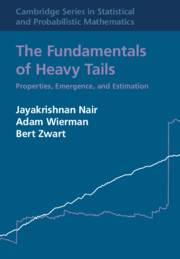Refine search
Actions for selected content:
980 results in Applied probability and stochastic networks
References
-
- Book:
- The Fundamentals of Heavy Tails
- Published online:
- 17 May 2022
- Print publication:
- 09 June 2022, pp 240-248
-
- Chapter
- Export citation
2 - Scale Invariance, Power Laws, and Regular Variation
- from Part I - Properties
-
- Book:
- The Fundamentals of Heavy Tails
- Published online:
- 17 May 2022
- Print publication:
- 09 June 2022, pp 29-55
-
- Chapter
- Export citation
6 - Multiplicative Processes
- from Part II - Emergence
-
- Book:
- The Fundamentals of Heavy Tails
- Published online:
- 17 May 2022
- Print publication:
- 09 June 2022, pp 127-147
-
- Chapter
- Export citation
Part II - Emergence
-
- Book:
- The Fundamentals of Heavy Tails
- Published online:
- 17 May 2022
- Print publication:
- 09 June 2022, pp 105-106
-
- Chapter
- Export citation
9 - Estimating Power-Law Tails: Let the Tail Do the Talking
- from Part III - Estimation
-
- Book:
- The Fundamentals of Heavy Tails
- Published online:
- 17 May 2022
- Print publication:
- 09 June 2022, pp 197-237
-
- Chapter
- Export citation
Acknowledgments
-
- Book:
- The Fundamentals of Heavy Tails
- Published online:
- 17 May 2022
- Print publication:
- 09 June 2022, pp xiii-xiv
-
- Chapter
- Export citation
4 - Residual Lives, Hazard Rates, and Long Tails
- from Part I - Properties
-
- Book:
- The Fundamentals of Heavy Tails
- Published online:
- 17 May 2022
- Print publication:
- 09 June 2022, pp 85-104
-
- Chapter
- Export citation
8 - Estimating Power-Law Distributions: Listen to the Body
- from Part III - Estimation
-
- Book:
- The Fundamentals of Heavy Tails
- Published online:
- 17 May 2022
- Print publication:
- 09 June 2022, pp 177-196
-
- Chapter
- Export citation
Contents
-
- Book:
- The Fundamentals of Heavy Tails
- Published online:
- 17 May 2022
- Print publication:
- 09 June 2022, pp v-viii
-
- Chapter
- Export citation
Preface
-
- Book:
- The Fundamentals of Heavy Tails
- Published online:
- 17 May 2022
- Print publication:
- 09 June 2022, pp ix-xii
-
- Chapter
- Export citation
Commonly Used Notation
-
- Book:
- The Fundamentals of Heavy Tails
- Published online:
- 17 May 2022
- Print publication:
- 09 June 2022, pp 238-239
-
- Chapter
- Export citation
5 - Additive Processes
- from Part II - Emergence
-
- Book:
- The Fundamentals of Heavy Tails
- Published online:
- 17 May 2022
- Print publication:
- 09 June 2022, pp 107-126
-
- Chapter
- Export citation
Index
-
- Book:
- The Fundamentals of Heavy Tails
- Published online:
- 17 May 2022
- Print publication:
- 09 June 2022, pp 249-250
-
- Chapter
- Export citation
3 - Catastrophes, Conspiracies, and Subexponential Distributions
- from Part I - Properties
-
- Book:
- The Fundamentals of Heavy Tails
- Published online:
- 17 May 2022
- Print publication:
- 09 June 2022, pp 56-84
-
- Chapter
- Export citation

The Fundamentals of Heavy Tails
- Properties, Emergence, and Estimation
-
- Published online:
- 17 May 2022
- Print publication:
- 09 June 2022
Frontmatter
-
- Book:
- Large-Scale System Analysis Under Uncertainty
- Published online:
- 17 January 2022
- Print publication:
- 17 February 2022, pp i-iv
-
- Chapter
- Export citation
8 - Discrete-Time Systems: Set-Theoretic Input Uncertainty
-
- Book:
- Large-Scale System Analysis Under Uncertainty
- Published online:
- 17 January 2022
- Print publication:
- 17 February 2022, pp 237-272
-
- Chapter
- Export citation
Preface and Acknowledgments
-
- Book:
- Large-Scale System Analysis Under Uncertainty
- Published online:
- 17 January 2022
- Print publication:
- 17 February 2022, pp xi-xii
-
- Chapter
- Export citation
2 - Preliminaries
-
- Book:
- Large-Scale System Analysis Under Uncertainty
- Published online:
- 17 January 2022
- Print publication:
- 17 February 2022, pp 16-53
-
- Chapter
- Export citation
Appendix B - Power Flow Modeling
-
- Book:
- Large-Scale System Analysis Under Uncertainty
- Published online:
- 17 January 2022
- Print publication:
- 17 February 2022, pp 320-329
-
- Chapter
- Export citation
